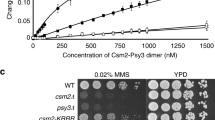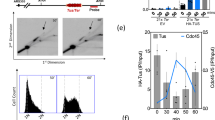Abstract
Chromatin rearrangement occurs during nucleotide excision repair (NER). Here we show that Snf6 and Snf5, two subunits of the SWI/SNF chromatin-remodeling complex in Saccharomyces cerevisiae, copurify with the NER damage-recognition heterodimer Rad4–Rad23. This interaction between SWI/SNF and Rad4–Rad23 is stimulated by UV irradiation. We demonstrate that NER in the transcriptionally silent, nucleosome-loaded HML locus is reduced in yeast cells lacking functional SWI/SNF. In addition, using a restriction enzyme accessibility assay, we observed UV-induced nucleosome rearrangement at the silent HML locus. Notably, this rearrangement is markedly attenuated when SWI/SNF is inactivated. These results indicate that the SWI/SNF chromatin-remodeling complex is recruited to DNA lesions by damage-recognition proteins to increase DNA accessibility for NER in chromatin.
This is a preview of subscription content, access via your institution
Access options
Subscribe to this journal
Receive 12 print issues and online access
$189.00 per year
only $15.75 per issue
Buy this article
- Purchase on Springer Link
- Instant access to full article PDF
Prices may be subject to local taxes which are calculated during checkout






Similar content being viewed by others
References
Hoeijmakers, J.H. Genome maintenance mechanisms for preventing cancer. Nature 411, 366–374 (2001).
Hanawalt, P.C. Genomic instability: environmental invasion and the enemies within. Mutat. Res. 400, 117–125 (1998).
Gale, J.M., Nissen, K.A. & Smerdon, M.J. UV-induced formation of pyrimidine dimers in nucleosome core DNA is strongly modulated with a period of 10.3 bases. Proc. Natl. Acad. Sci. USA 84, 6644–6648 (1987).
Smerdon, M.J. & Lieberman, M.W. Nucleosome rearrangement in human chromatin during UV-induced DNA-repair synthesis. Proc. Natl. Acad. Sci. USA 75, 4238–4241 (1978).
Yu, Y., Teng, Y., Liu, H., Reed, S.H. & Waters, R. UV irradiation stimulates histone acetylation and chromatin remodeling at a repressed yeast locus. Proc. Natl. Acad. Sci. USA 102, 8650–8655 (2005).
Smith, C.L. & Peterson, C.L. ATP-dependent chromatin remodeling. Curr. Top. Dev. Biol. 65, 115–148 (2005).
Gaillard, H. et al. Chromatin remodeling activities act on UV-damaged nucleosomes and modulate DNA damage accessibility to photolyase. J. Biol. Chem. 278, 17655–17663 (2003).
Hara, R. & Sancar, A. The SWI/SNF chromatin-remodeling factor stimulates repair by human excision nuclease in the mononucleosome core particle. Mol. Cell. Biol. 22, 6779–6787 (2002).
Martens, J.A. & Winston, F. Recent advances in understanding chromatin remodeling by Swi/Snf complexes. Curr. Opin. Genet. Dev. 13, 136–142 (2003).
Mone, M.J. et al. In vivo dynamics of chromatin-associated complex formation in mammalian nucleotide excision repair. Proc. Natl. Acad. Sci. USA 101, 15933–15937 (2004).
Green, C.M. & Almouzni, G. When repair meets chromatin. First in series on chromatin dynamics. EMBO Rep. 3, 28–33 (2002).
Gong, F., Kwon, Y. & Smerdon, M.J. Nucleotide excision repair in chromatin and the right of entry. DNA Repair (Amst.) 4, 884–896 (2005).
Jansen, L.E., Verhage, R.A. & Brouwer, J. Preferential binding of yeast Rad4Rad23 complex to damaged DNA. J. Biol. Chem. 273, 33111–33114 (1998).
Volker, M. et al. Sequential assembly of the nucleotide excision repair factors in vivo. Mol. Cell 8, 213–224 (2001).
Hall, D.B. & Struhl, K. The VP16 activation domain interacts with multiple transcriptional components as determined by protein-protein cross-linking in vivo. J. Biol. Chem. 277, 46043–46050 (2002).
Elsasser, S., Chandler-Militello, D., Muller, B., Hanna, J. & Finley, D. Rad23 and Rpn10 serve as alternative ubiquitin receptors for the proteasome. J. Biol. Chem. 279, 26817–26822 (2004).
Suzuki, T., Park, H., Kwofie, M.A. & Lennarz, W.J. Rad23 provides a link between the Png1 deglycosylating enzyme and the 26S proteasome in yeast. J. Biol. Chem. 276, 21601–21607 (2001).
Kim, I. et al. The Png1-Rad23 complex regulates glycoprotein turnover. J. Cell Biol. 172, 211–219 (2006).
Reardon, J.T., Bessho, T., Kung, H.C., Bolton, P.H. & Sancar, A. In vitro repair of oxidative DNA damage by human nucleotide excision repair system: possible explanation for neurodegeneration in xeroderma pigmentosum patients. Proc. Natl. Acad. Sci. USA 94, 9463–9468 (1997).
Weiss, K. & Simpson, R.T. High-resolution structural analysis of chromatin at specific loci: Saccharomyces cerevisiae silent mating type locus HMLalpha. Mol. Cell. Biol. 18, 5392–5403 (1998).
Verhage, R. et al. The RAD7 and RAD16 genes, which are essential for pyrimidine dimer removal from the silent mating type loci, are also required for repair of the nontranscribed strand of an active gene in Saccharomyces cerevisiae. Mol. Cell. Biol. 14, 6135–6142 (1994).
Laurent, B.C., Treitel, M.A. & Carlson, M. Functional interdependence of the yeast SNF2, SNF5, and SNF6 proteins in transcriptional activation. Proc. Natl. Acad. Sci. USA 88, 2687–2691 (1991).
Peterson, C.L., Dingwall, A. & Scott, M.P. Five SWI/SNF gene products are components of a large multisubunit complex required for transcriptional enhancement. Proc. Natl. Acad. Sci. USA 91, 2905–2908 (1994).
Guzder, S.N., Sung, P., Prakash, L. & Prakash, S. Synergistic interaction between yeast nucleotide excision repair factors NEF2 and NEF4 in the binding of ultraviolet-damaged DNA. J. Biol. Chem. 274, 24257–24262 (1999).
den Dulk, B., Sun, S.M., de Ruijter, M., Brandsma, J.A. & Brouwer, J. Rad33, a new factor involved in nucleotide excision repair in Saccharomyces cerevisae. DNA Repair (Amst.) 5, 683–692 (2006).
Prakash, S. & Prakash, L. Nucleotide excision repair in yeast. Mutat. Res. 451, 13–24 (2000).
Sugasawa, K. et al. Xeroderma pigmentosum group C protein complex is the initiator of global genome nucleotide excision repair. Mol. Cell 2, 223–232 (1998).
Neely, K.E. & Workman, J.L. The complexity of chromatin remodeling and its links to cancer. Biochim. Biophys. Acta 1603, 19–29 (2002).
Roberts, C.W. & Orkin, S.H. The SWI/SNF complex-chromatin and cancer. Nat. Rev. Cancer 4, 133–142 (2004).
Chai, B., Huang, J., Cairns, B.R. & Laurent, B.C. Distinct roles for the RSC and Swi/Snf ATP-dependent chromatin remodelers in DNA double-strand break repair. Genes Dev. 19, 1656–1661 (2005).
Li, S. & Smerdon, M.J. Rpb4 and Rpb9 mediate subpathways of transcription-coupled DNA repair in Saccharomyces cerevisiae. EMBO J. 21, 5921–5929 (2002).
Sweder, K.S. & Hanawalt, P.C. Preferential repair of cyclobutane pyrimidine dimers in the transcribed strand of a gene in yeast chromosomes and plasmids is dependent on transcription. Proc. Natl. Acad. Sci. USA 89, 10696–10700 (1992).
Thoma, F. Mapping of nucleosome positions. Methods Enzymol. 274, 197–214 (1996).
Acknowledgements
We are grateful to E. O'Shea for supplying yeast strains at an early stage of this study. This study was made possible by US National Institutes of Health grants ES02614 and ES04106 from the National Institute of Environmental Health Sciences (to M.J.S.) and grant IRG-77-003-26 from the American Cancer Society (to F.G.).
Author information
Authors and Affiliations
Contributions
F.G. and M.J.S designed the experiments. F.G. and D.F. did the experiments. F.G., D.F. and M.J.S interpreted the results. F.G. prepared the manuscript and M.J.S., D.F. and F.G. revised the manuscript.
Corresponding authors
Ethics declarations
Competing interests
The authors declare no competing financial interests.
Rights and permissions
About this article
Cite this article
Gong, F., Fahy, D. & Smerdon, M. Rad4–Rad23 interaction with SWI/SNF links ATP-dependent chromatin remodeling with nucleotide excision repair. Nat Struct Mol Biol 13, 902–907 (2006). https://doi.org/10.1038/nsmb1152
Received:
Accepted:
Published:
Issue Date:
DOI: https://doi.org/10.1038/nsmb1152
This article is cited by
-
Multiple functions of SWI/SNF chromatin remodeling complex in plant-pathogen interactions
Stress Biology (2021)
-
Nucleotide excision repair leaves a mark on chromatin: DNA damage detection in nucleosomes
Cellular and Molecular Life Sciences (2021)
-
Exome sequencing identifies novel mutation signatures of UV radiation and trichostatin A in primary human keratinocytes
Scientific Reports (2020)
-
DNA damage sensitivity of SWI/SNF-deficient cells depends on TFIIH subunit p62/GTF2H1
Nature Communications (2018)
-
ATP-dependent chromatin remodeling in the DNA-damage response
Epigenetics & Chromatin (2012)



